Challenge A: Cosmic
Cat Body Language 101
September 25, 2025
Nico Cai
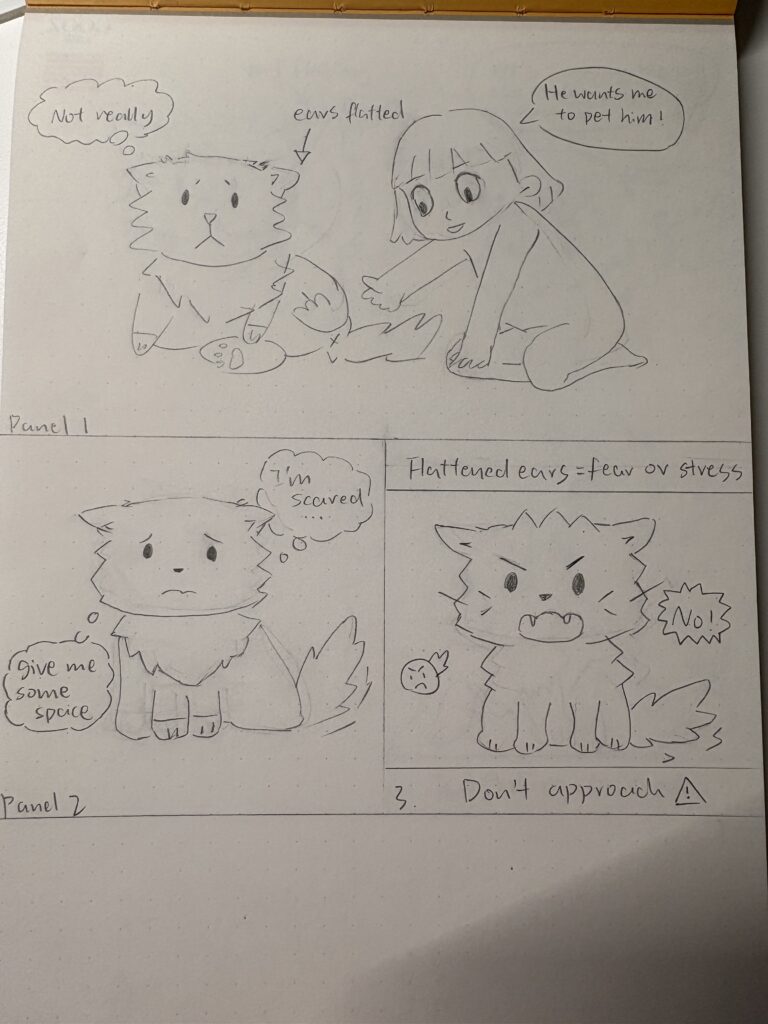
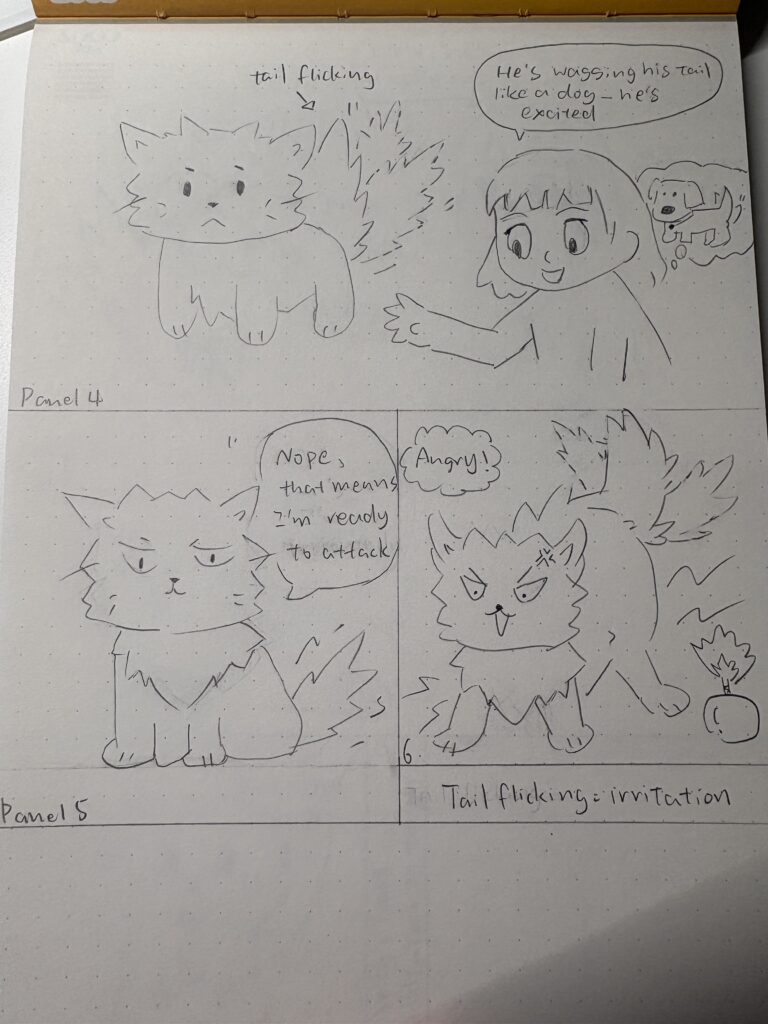
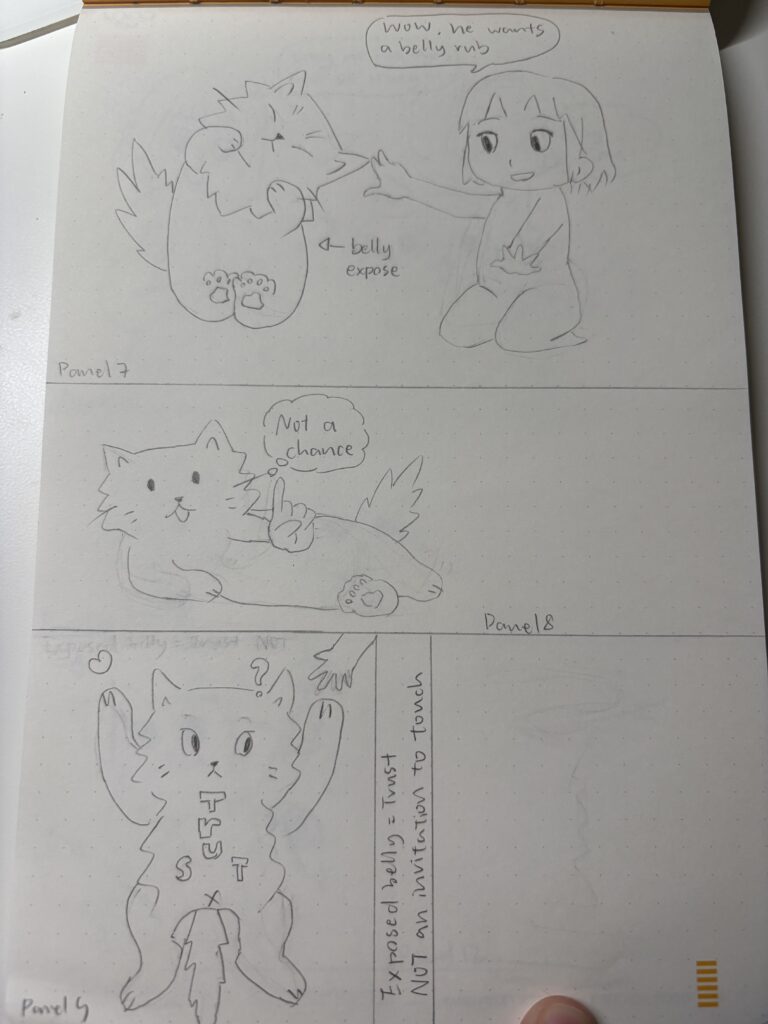
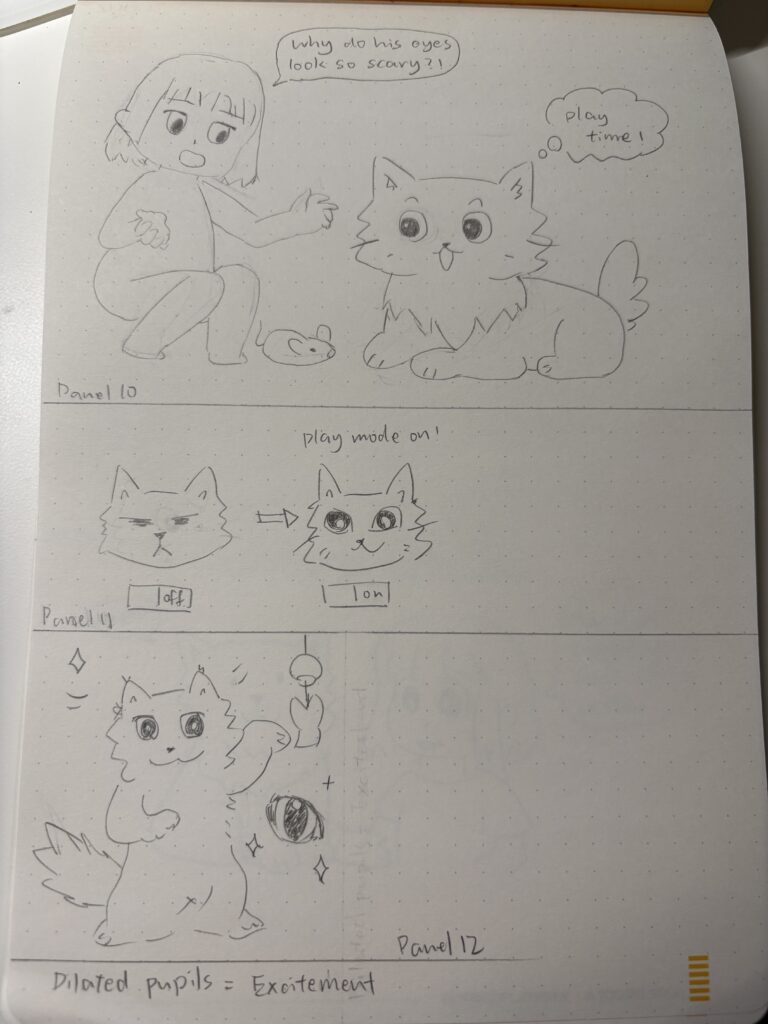
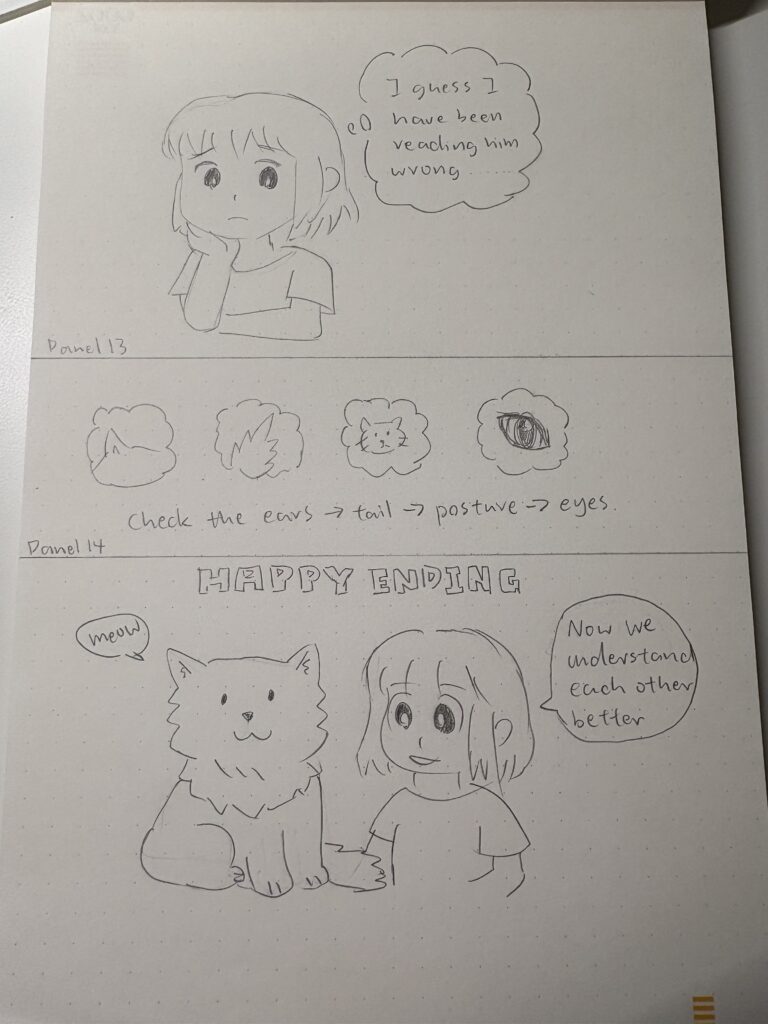
Introduction
The goal of my project was to design an educational comic that teaches children and new pet owners how to correctly interpret common cat body language. The inspiration for my comic comes from my own Maine Coon. When he was a kitten, I often couldn’t understand his body language and sometimes misread what he wanted. As we spent more time together, our communication slowly became more in sync. I realized that although you can’t talk to a cat directly, you can build a stronger bond by learning to read their signals. I hope people could better understand their feline friend through this cosmic.
Understand Phase
Challenge
Many new cat owners may misread their cat’s body language. Unlike dogs, cats flick their tails to show a signal of warning instead of being friendly. Misunderstanding these cues can lead to scratches, bites, or broken trust between cats and their humans. Therefore, the challenge addressed by this project lies in creating a learning resource that clearly explains the true meaning of these signals, which avoids causing harm while fostering a more respectful and empathetic relationship between cats and their caregivers.
Audience
The audience for this comic is broad but is especially focused on children and first-time cat owners who may have little prior knowledge of feline behavior. Young readers benefit from simple drawings, short text, and a narrative that feels playful, while adults can use the same resource as a quick and memorable reminder of how to interact safely with their pets. This comic’s target readers also include people who prefer quick, visually engaging resources such as comics, memes, or short social media posts instead of reading lengthy articles or books. This comic targets a hybrid audience that values clarity and efficiency. It serves as both an educational tool and an engaging story that fosters empathy and a sense of responsibility in pet owners.
POV
New cat owners need to learn how to correctly interpret common cat body language cues so that they can build trust, avoid conflict, and create a safer, more loving environment for their pets.
Learning Objectives
By the end of this comic, learners will be able to:
- Recognize four common cat body language signals: ears back, tail flicking, belly showing, and dilated pupils. Each of these cues has a specific meaning that is often misunderstood.
- Distinguish between behaviors that indicate trust and happiness versus those that indicate stress or angry. Learning to interpret them correctly is essential for building a safe and trusting relationship with a pet.
- Apply this knowledge in daily interactions in order to lead to safer and more positive human-cat relationships.
- Develop a deeper empathy for your cat’s emotions and become a more responsible pet owner. (Hidden objective)
Plan Phase
Ideation
When I was brainstorming for this project, I remembered asking my breeder why my kitten was “making noises.” The breeder explained that the kitten was actually purring because he felt happy and comfortable, and that these sounds were a way of interacting with me, which sometimes even signaled hunger. This experience sparked my interest in understanding cat body language more deeply. Most of what I have learned since then has come from YouTube videos and RedNote posts that explain feline behavior in simple, engaging ways.
The most promising prototype I developed is a comic that highlights four commonly misunderstood cat signals: flattened ears, tail flicking, belly showing and dilated pupils, and uses humor and short explanations to help owners interpret them correctly.
Scripts
Panel 1
Visual: The cat’s ears are flattened back while the owner reaches out to pet.
Owner (speech bubble): “He wants me to pet him!”
Cat (thought bubble): “Not really…”
Caption: Flattened ears usually mean fear or stress.
Panel 2
Visual: The cat sits with its ears back, looking nervous.
Cat (thought bubble): “I’m scared.”
Small bubble: “Give me some space.”
Panel 3
Visual: The cat hisses with fur.
Cat (shouting): “NO!”
Caption: Do not approach when ears are flattened.
Panel 4
Visual: The cat’s tail flicks back and forth. The owner misinterprets.
Owner (speech bubble): “He’s wagging his tail like a dog—he’s excited!”
Caption (small arrow): Tail flicking.
Panel 5
Visual: The cat looks unimpressed.
Cat (speech bubble): “Nope, that means I’m ready to attack.”
Panel 6
Visual: The cat arches its back, tail lashing, looking furious.
Cat (speech bubble): “Angry!”
Caption: Tail flicking means irritation.
Panel 7
Visual: The cat rolls over and shows its belly. The owner misunderstands.
Owner (speech bubble): “Wow, he wants a belly rub!”
Panel 8
Visual: The cat shook its head and said no.
Cat (thought bubble): “Not a chance!”
Panel 9
Visual: Info card with cat lying on its back, the word “TRUST” written across its body.
Caption: Exposed belly = trust, but NOT an invitation to touch.
Panel 10
Visual: The cat’s pupils suddenly enlarge. The owner looks worried.
Owner (speech bubble): “Why do his eyes look so scary?”
Cat (thought bubble): “Play time!”
Panel 11
Visual: The cat’s eyes switch from narrow (“off”) to wide and sparkling (“on”).
Caption: Play mode on!
Panel 12
Visual: The cat stands upright with dilated pupils, focused on a toy.
Caption: Dilated pupils = excitement.
Panel 13
Visual: The owner reflects, looking thoughtful.
Owner (thought bubble): “I guess I have been reading him wrong.”
Panel 14
Visual: Icons of ears, tail, posture, and eyes appear as reminders, followed by a happy ending scene of the cat and owner together.
Text: “Check the ears → tail → posture → eyes.”
Panel 14
Owner (speech bubble): “Now we understand each other better.”
Cat (speech bubble): “Meow!”
Principle
This comic uses some educational multimedia design principles to make the content clear and engaging. Each panel follows the coherence principle by focusing only on one cat body signal without distractions. Signaling is used through arrows and caption cards to highlight important features and contiguity ensures that text is placed directly beside the corresponding images. The story is also segmented into four short scenes, each teaching a single behavior, which helps readers process information step by step. Finally, the cat’s humorous “inner voice” adds a personalization effect, making the learning experience more memorable.
Peer feedback
Both of my peers provided thoughtful and helpful feedback that gave me a clearer sense of the strengths of my comic as well as the areas that could be improved. Their comments were encouraging and also offered specific suggestions that I could consider for refinement.
One classmate appreciated how the comic highlighted body language signals such as tail flicking, ears back, belly showing, and dilated pupils, and they noted that the cat’s inner thoughts made the story more engaging. At the same time, they recommended adding more context to panels two and three, using a clearer and larger font, and incorporating color to hold attention more effectively.
The other classmate highlighted the contrast between dogs and cats in panel four and felt that the comic ended in a wholesome way. Their main suggestions were to use clearer outlines and borders, add color for a stronger visual impact, and clarify panels eleven and twelve, since both described dilated pupils as a sign of excitement or play.
Reflect and Refine
One aspect that worked particularly well in this project was the overall clarity of the storyline. The sequence of misinterpretation followed by correction gave the comic a natural rhythm that was easy for readers to follow. The use of the cat’s inner thoughts added humor and personality, which made the comic more engaging for children and new pet owners. The consistent focus on four specific signals, which were ears back, tail flicking, belly showing, and pupil dilation, helped keep the learning objectives clear throughout.
At the same time, some areas could be improved. The absence of color limited the visual impact of the panels, and some of the earlier drawings(especially panels two and three) did not provide enough text to make the intended meaning immediately clear. There were also small inconsistencies in line thickness and borders that made the comic appear less polished. In addition, the explanation of dilated pupils in panels eleven and twelve needed clarification to avoid repetition and possible confusion.
In response to these issues, I refined the drawings to make facial expressions and gestures more distinct, added extra text where it was needed for clarity, and adjusted the spacing and outlines to improve overall readability. Although I did not add color because of the limitations of my materials, I ensured that the black and white style remained clean and easy to understand. These changes allowed the final version to communicate its message more effectively while staying true to the hand-drawn style.
Through this process, I learned how much small design decisions, such as the placement of text bubbles or the consistency of borders, can affect the overall readability of a comic. I also learned the importance of peer feedback in revealing blind spots, such as panels that seemed underdeveloped or explanations that needed greater clarity. The experience reinforced the value of combining theory with practice, since the principles of coherence, signaling, and segmenting became much more tangible once I applied them directly to my drawings.
The strengths of this project lie in its relatable narrative, clear educational purpose, and use of multimedia learning principles to guide the design. The main limitations come from the lack of color and the absence of digital tools, which would have made the comic more visually striking and professional. Despite these constraints, the project demonstrates that even a simple hand-drawn comic can be an effective instructional resource when it is carefully planned, theory-driven, and refined through feedback.
Reference
Theories of Multimedia Learning – EDCI 337. (2025b, September 5). https://edtechuvic.ca/edci337/2025/09/05/theories-of-multimedia-learning/
Storytelling – EDCI 337. (2025, September 14). https://edtechuvic.ca/edci337/2025/09/14/storytelling/